indicator Citroen GRAND C4 PICASSO 2017 2.G Service Manual
[x] Cancel search | Manufacturer: CITROEN, Model Year: 2017, Model line: GRAND C4 PICASSO, Model: Citroen GRAND C4 PICASSO 2017 2.GPages: 527, PDF Size: 12.91 MB
Page 83 of 527
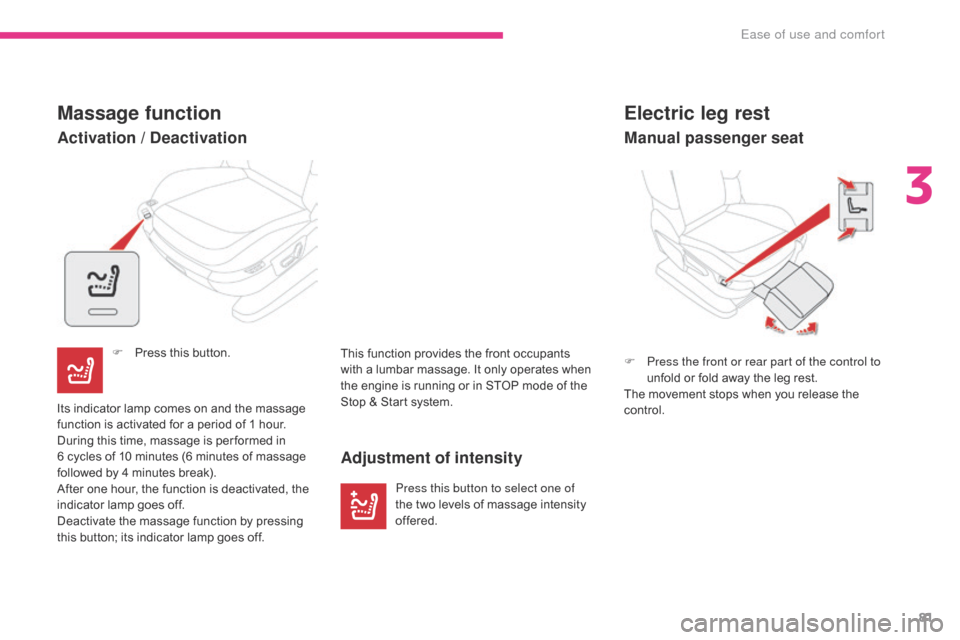
81
C4-Picasso-II_en_Chap03_ergonomie-confort_ed02-2016
Electric leg rest
F Press the front or rear part of the control to unfold or fold away the leg rest.
The movement stops when you release the
control.
Activation / Deactivation
Massage function
This function provides the front occupants
with a lumbar massage. It only operates when
the engine is running or in STOP mode of the
Stop
& Start system.
F
P
ress this button.
Adjustment of intensity
Press this button to select one of
the two levels of massage intensity
offered.
Its indicator lamp comes on and the massage
function is activated for a period of 1 hour.
During this time, massage is per formed in
6
cycles of 10 minutes (6 minutes of massage
followed by 4 minutes break).
After one hour, the function is deactivated, the
indicator lamp goes off.
Deactivate the massage function by pressing
this button; its indicator lamp goes off.
Manual passenger seat
3
Ease of use and comfort
Page 98 of 527
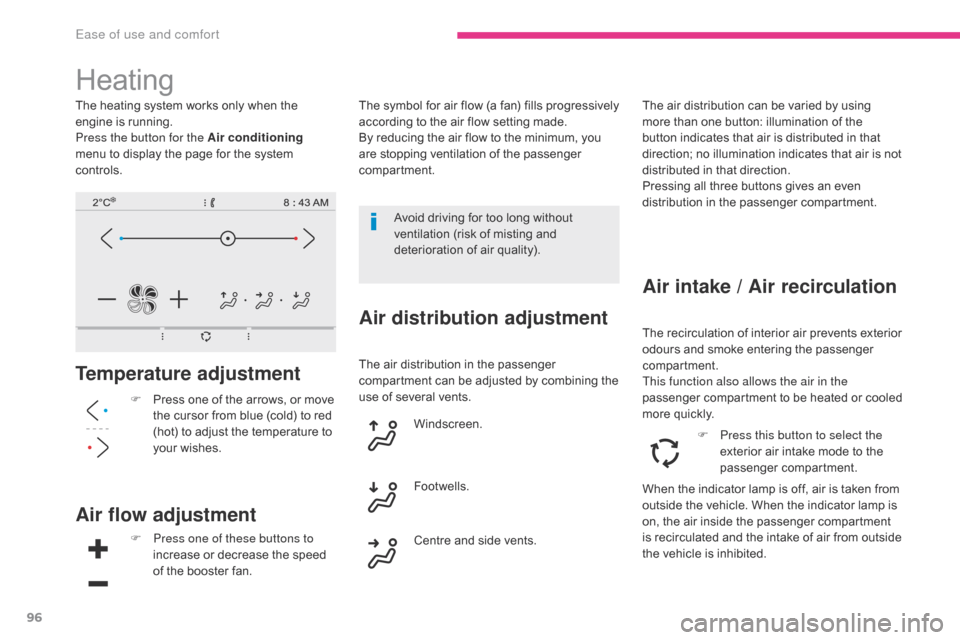
96
C4-Picasso-II_en_Chap03_ergonomie-confort_ed02-2016
Heating
Temperature adjustment
F Press one of the arrows, or move the cursor from blue (cold) to red
(hot) to adjust the temperature to
your wishes.
Air flow adjustment
F Press one of these buttons to increase or decrease the speed
of the booster fan.
Air distribution adjustmentThe recirculation of interior air prevents exterior
odours and smoke entering the passenger
compartment.
This function also allows the air in the
passenger compartment to be heated or cooled
more quickly.
Windscreen.
Centre and side vents. Footwells. The air distribution can be varied by using
more than one button: illumination of the
button indicates that air is distributed in that
direction; no illumination indicates that air is not
distributed in that direction.
Pressing all three buttons gives an even
distribution in the passenger compartment.
Air intake / Air recirculation
F Press this button to select the
exterior air intake mode to the
passenger compartment.
Avoid driving for too long without
ventilation (risk of misting and
deterioration of air quality).
The heating system works only when the
engine is running.
Press the button for the Air conditioning
menu to display the page for the system
controls. The symbol for air flow (a fan) fills progressively
according to the air flow setting made.
By reducing the air flow to the minimum, you
are stopping ventilation of the passenger
compartment.
The air distribution in the passenger
compartment can be adjusted by combining the
use of several vents.
When the indicator lamp is off, air is taken from
outside the vehicle. When the indicator lamp is
on, the air inside the passenger compartment
is recirculated and the intake of air from outside
the vehicle is inhibited.
Ease of use and comfort
Page 100 of 527

98
C4-Picasso-II_en_Chap03_ergonomie-confort_ed02-2016
Air intake / Air recirculation
The intake of exterior air prevents the formation
of mist on the windscreen and side windows.
The recirculation of interior air isolates the
passenger compartment from exterior odours
and smoke.F
P
ress this button to choose
how air enters the passenger
compartment.
Air conditioning On / Off
Switching on
Switching off
The air conditioning does not operate
when the air flow adjustment is set
to
off.F
P
ress this button to activate the
air conditioning system.
Avoid driving for too long with
recirculation of interior air (risk of
misting and deterioration of air quality). This function allows hot or cold air to be
delivered selectively and more quickly. The air conditioning is designed to operate
effectively in all seasons, with the windows closed.
It enables you to:
-
l
ower the temperature, in summer,
-
i
ncrease the effectiveness of the demisting in
winter, above 3°C.
F
P
ress this button again to
deactivate the air conditioning
system.
Air distribution adjustment
These buttons are used to arrange
the distribution of air in the passenger
compartment by combining several air outlets.
Windscreen.
The air distribution can be adapted by using
several buttons: illumination of the button
confirms the presence of fan boosted air in
the direction indicated, the button going off
indicates the absence of fan boosted air in the
direction indicated.
For a uniform distribution of air in the
passenger compartment, the three buttons can
be used simultaneously. Footwells.
Central and side vents.
When the indicator lamp is off, air is taken from
outside the vehicle. When the indicator lamp is
on, air is recirculated from inside the vehicle,
the intake for air outside the vehicle is inhibited. When the indicator lamp is on, the air
conditioning function is activated.
When the indicator lamp is off, the air
conditioning function is deactivated.
Ease of use and comfort
Page 102 of 527
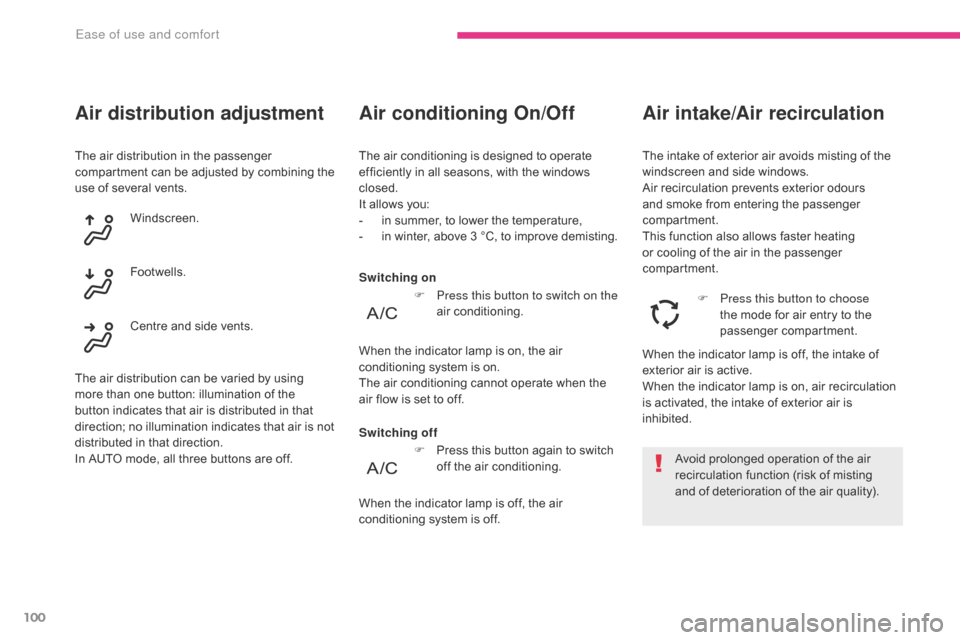
100
C4-Picasso-II_en_Chap03_ergonomie-confort_ed02-2016
The air distribution in the passenger
compartment can be adjusted by combining the
use of several vents.
Air distribution adjustment
Windscreen.
Footwells.
Centre and side vents.
The air distribution can be varied by using
more than one button: illumination of the
button indicates that air is distributed in that
direction; no illumination indicates that air is not
distributed in that direction.
In AUTO mode, all three buttons are off. Switching off Switching on
Air conditioning On/Off
The air conditioning is designed to operate
efficiently in all seasons, with the windows
closed.
It allows you:
-
i
n summer, to lower the temperature,
-
i
n winter, above 3 °C, to improve demisting.
Avoid prolonged operation of the air
recirculation function (risk of misting
and of deterioration of the air quality).
When the indicator lamp is off, the intake of
exterior air is active.
When the indicator lamp is on, air recirculation
is activated, the intake of exterior air is
inhibited.
F
P
ress this button to choose
the mode for air entry to the
passenger compartment.
The intake of exterior air avoids misting of the
windscreen and side windows.
Air recirculation prevents exterior odours
and smoke from entering the passenger
compartment.
This function also allows faster heating
or cooling of the air in the passenger
compartment.
Air intake/Air recirculation
F Press this button again to switch
off the air conditioning.
When the indicator lamp is off, the air
conditioning system is off. F
P
ress this button to switch on the
air conditioning.
When the indicator lamp is on, the air
conditioning system is on.
The air conditioning cannot operate when the
air flow is set to off.
Ease of use and comfort
Page 103 of 527
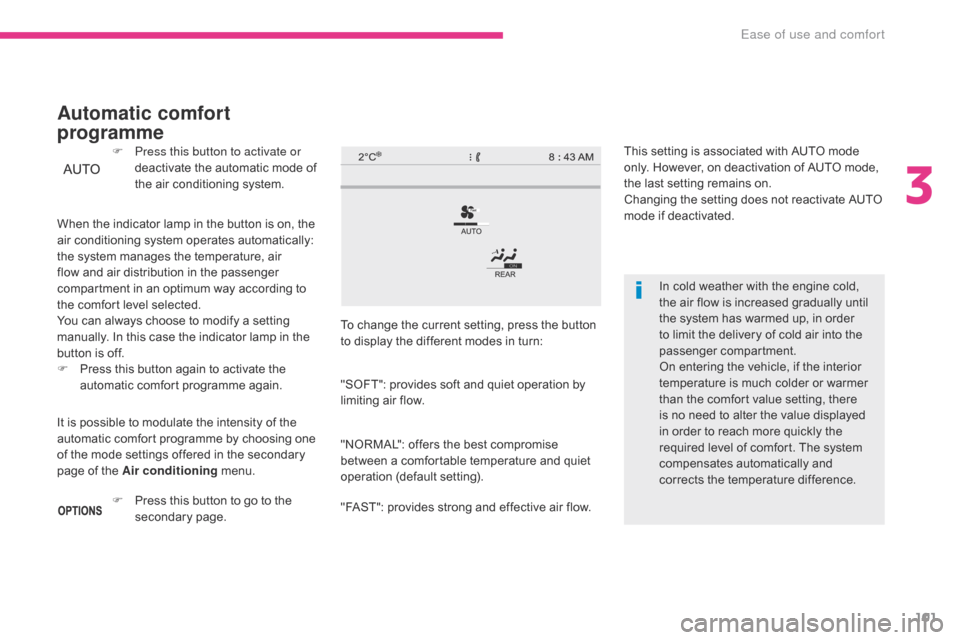
101
C4-Picasso-II_en_Chap03_ergonomie-confort_ed02-2016
In cold weather with the engine cold,
the air flow is increased gradually until
the system has warmed up, in order
to limit the delivery of cold air into the
passenger compartment.
On entering the vehicle, if the interior
temperature is much colder or warmer
than the comfort value setting, there
is no need to alter the value displayed
in order to reach more quickly the
required level of comfort. The system
compensates automatically and
corrects the temperature difference.
This setting is associated with AUTO mode
only. However, on deactivation of AUTO mode,
the last setting remains on.
Changing the setting does not reactivate AUTO
mode if deactivated.
When the indicator lamp in the button is on, the
air conditioning system operates automatically:
the system manages the temperature, air
flow and air distribution in the passenger
compartment in an optimum way according to
the comfort level selected.
You can always choose to modify a setting
manually. In this case the indicator lamp in the
button is off.
F
P
ress this button again to activate the
automatic comfort programme again. F
P
ress this button to activate or
deactivate the automatic mode of
the air conditioning system.
Automatic comfort
programme
To change the current setting, press the button
to display the different modes in turn:
"SOFT": provides soft and quiet operation by
limiting air flow.
"NORMAL": offers the best compromise
between a comfortable temperature and quiet
operation (default setting).
"FAST": provides strong and effective air flow.
It is possible to modulate the intensity of the
automatic comfort programme by choosing one
of the mode settings offered in the secondary
page of the Air conditioning
menu.
F
P
ress this button to go to the
secondary page.
3
Ease of use and comfort
Page 106 of 527
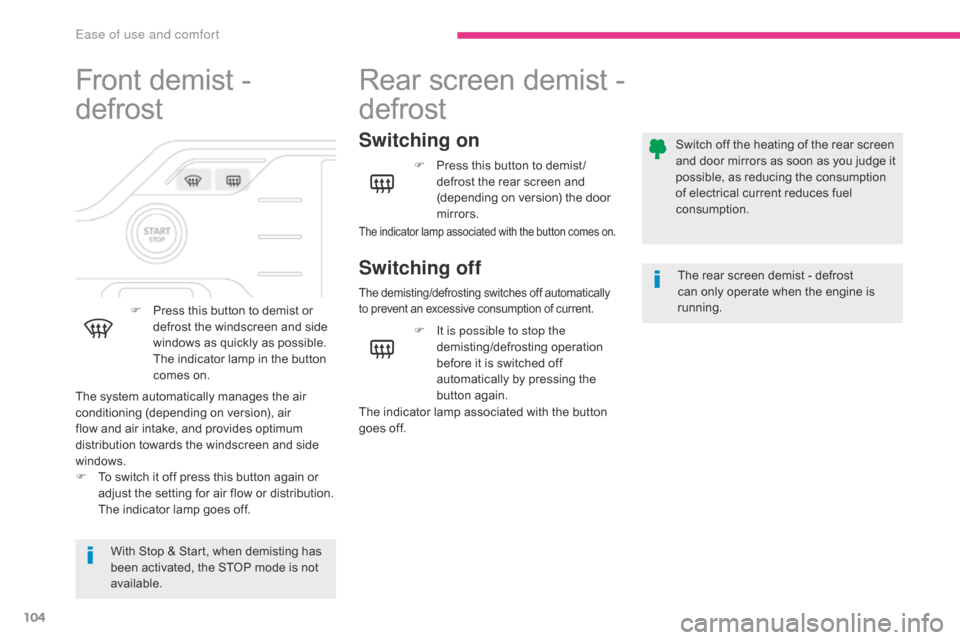
104
C4-Picasso-II_en_Chap03_ergonomie-confort_ed02-2016
Front demist -
defrost
F Press this button to demist or defrost the windscreen and side
windows as quickly as possible.
The indicator lamp in the button
comes on.
With Stop & Start, when demisting has
been activated, the STOP mode is not
available.
The system automatically manages the air
conditioning (depending on version), air
flow and air intake, and provides optimum
distribution towards the windscreen and side
windows.
F
T
o switch it off press this button again or
adjust the setting for air flow or distribution.
The indicator lamp goes off.
Rear screen demist -
defrost
Switching on
Switching off
F Press this button to demist / defrost the rear screen and
(depending on version) the door
mirrors.
The demisting/defrosting switches off automatically
to prevent an excessive consumption of current.
The rear screen demist - defrost
can only operate when the engine is
running.
Switch off the heating of the rear screen
and door mirrors as soon as you judge it
possible, as reducing the consumption
of electrical current reduces fuel
consumption.
F
I
t is possible to stop the
demisting/defrosting operation
before it is switched off
automatically by pressing the
button again.
The indicator lamp associated with the button
goes off.
The indicator lamp associated with the button comes on.
Ease of use and comfort
Page 117 of 527
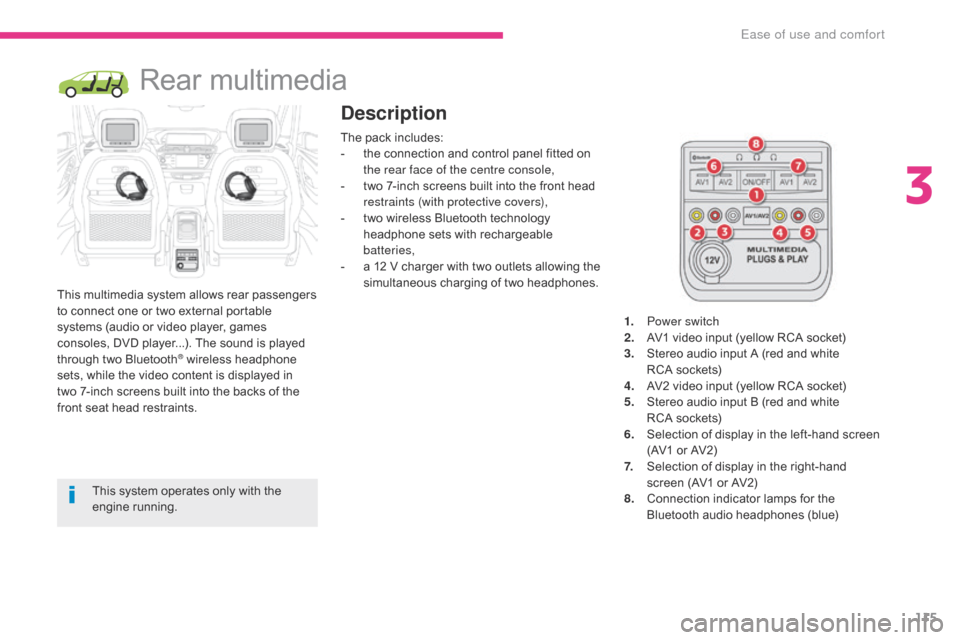
115
C4-Picasso-II_en_Chap03_ergonomie-confort_ed02-2016
Rear multimedia
This multimedia system allows rear passengers
to connect one or two external portable
systems (audio or video player, games
consoles, DVD player...). The sound is played
through two Bluetooth
® wireless headphone
sets, while the video content is displayed in
two
7-inch screens built into the backs of the
front seat head restraints.
Description
This system operates only with the
engine running. The pack includes:
-
t
he connection and control panel fitted on
the rear face of the centre console,
-
t
wo 7-inch screens built into the front head
restraints (with protective covers),
-
t
wo wireless Bluetooth technology
headphone sets with rechargeable
batteries,
-
a 1
2 V charger with two outlets allowing the
simultaneous charging of two headphones.
1.
P
ower switch
2.
A
V1 video input (yellow RCA socket)
3.
S
tereo audio input A (red and white
RCA sockets)
4.
A
V2 video input (yellow RCA socket)
5.
S
tereo audio input B (red and white
RCA sockets)
6.
S
election of display in the left-hand screen
(AV1 or AV2)
7.
S
election of display in the right-hand
screen (AV1 or AV2)
8. C onnection indicator lamps for the
Bluetooth audio headphones (blue)
3
Ease of use and comfort
Page 118 of 527
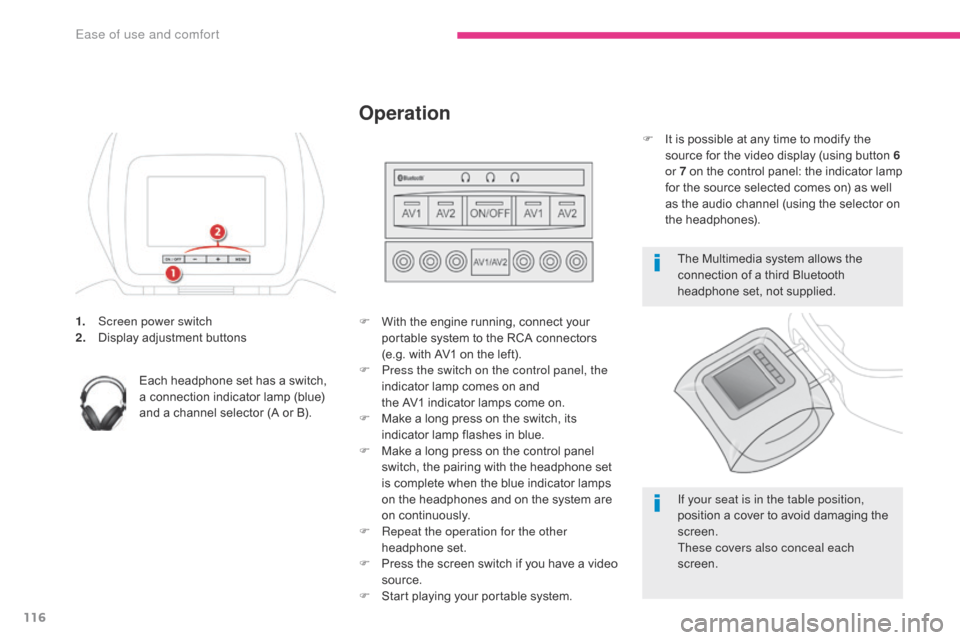
116
C4-Picasso-II_en_Chap03_ergonomie-confort_ed02-2016
1. Screen power switch
2. Display adjustment buttons
Each headphone set has a switch,
a connection indicator lamp (blue)
and a channel selector (A or B). F
W ith the engine running, connect your
portable system to the RCA connectors
(e.g. with AV1 on the left).
F
P
ress the switch on the control panel, the
indicator lamp comes on and
the AV1 indicator lamps come on.
F
M
ake a long press on the switch, its
indicator lamp flashes in blue.
F
M
ake a long press on the control panel
switch, the pairing with the headphone set
is complete when the blue indicator lamps
on the headphones and on the system are
on continuously.
F
R
epeat the operation for the other
headphone set.
F
P
ress the screen switch if you have a video
source.
F
S
tart playing your portable system.
Operation
The Multimedia system allows the
connection of a third Bluetooth
headphone set, not supplied.
If your seat is in the table position,
position a cover to avoid damaging the
screen.
These covers also conceal each
screen.
F
I
t is possible at any time to modify the
source for the video display (using button 6
or 7 on the control panel: the indicator lamp
for the source selected comes on) as well
as the audio channel (using the selector on
the headphones).
Ease of use and comfort
Page 135 of 527
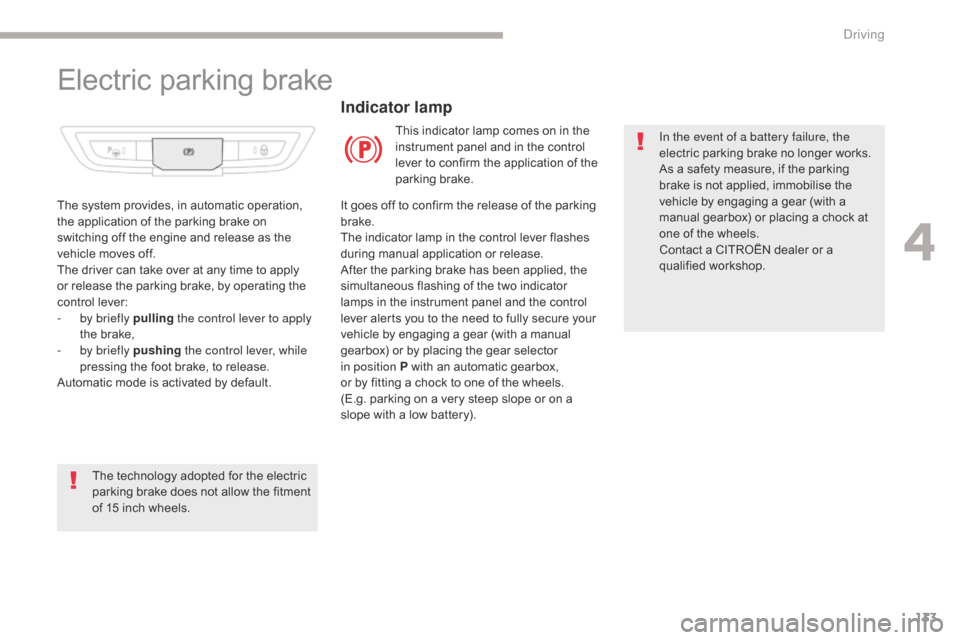
133
C4-Picasso-II_en_Chap04_conduite_ed02-2016
Electric parking brake
In the event of a battery failure, the
electric parking brake no longer works.
As a safety measure, if the parking
brake is not applied, immobilise the
vehicle by engaging a gear (with a
manual gearbox) or placing a chock at
one of the wheels.
Contact a CITROËN dealer or a
qualified workshop.
Indicator lamp
This indicator lamp comes on in the
instrument panel and in the control
lever to confirm the application of the
parking brake.
The system provides, in automatic operation,
the application of the parking brake on
switching off the engine and release as the
vehicle moves off.
The driver can take over at any time to apply
or release the parking brake, by operating the
control lever:
-
b
y briefly pulling the control lever to apply
the brake,
-
b
y briefly pushing the control lever, while
pressing the foot brake, to release.
Automatic mode is activated by default.
The technology adopted for the electric
parking brake does not allow the fitment
of 15 inch wheels. It goes off to confirm the release of the parking
brake.
The indicator lamp in the control lever flashes
during manual application or release.
After the parking brake has been applied, the
simultaneous flashing of the two indicator
lamps in the instrument panel and the control
lever alerts you to the need to fully secure your
vehicle by engaging a gear (with a manual
gearbox) or by placing the gear selector
in position P with an automatic gearbox,
or by fitting a chock to one of the wheels.
(E.g.
parking on a very steep slope or on a
slope with a low battery).
4
Driving
Page 136 of 527
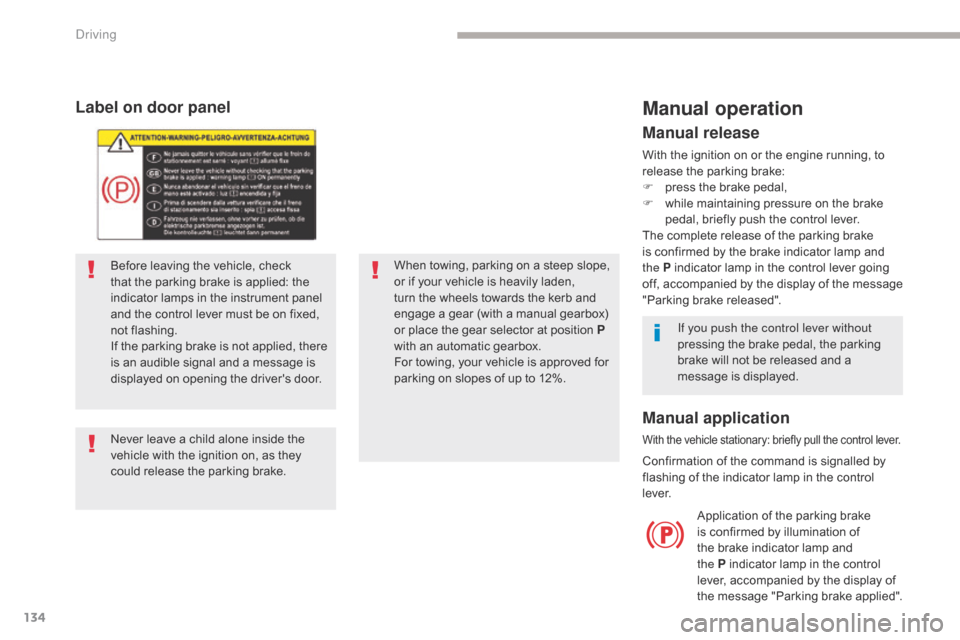
134
C4-Picasso-II_en_Chap04_conduite_ed02-2016
Label on door panel
Before leaving the vehicle, check
that the parking brake is applied: the
indicator lamps in the instrument panel
and the control lever must be on fixed,
not flashing.
If the parking brake is not applied, there
is an audible signal and a message is
displayed on opening the driver's door.
Never leave a child alone inside the
vehicle with the ignition on, as they
could release the parking brake.When towing, parking on a steep slope,
or if your vehicle is heavily laden,
turn the wheels towards the kerb and
engage a gear (with a manual gearbox)
or place the gear selector at position
P
with an automatic gearbox.
For towing, your vehicle is approved for
parking on slopes of up to 12%.
Manual operation
Application of the parking brake
is confirmed by illumination of
the brake indicator lamp and
the
P indicator lamp in the control
lever, accompanied by the display of
the message "Parking brake applied".
Manual release
With the ignition on or the engine running, to
release the parking brake:
F
p
ress the brake pedal,
F
w
hile maintaining pressure on the brake
pedal, briefly push the control lever.
The complete release of the parking brake
is confirmed by the brake indicator lamp and
the
P indicator lamp in the control lever going
off, accompanied by the display of the message
"Parking brake released".
If you push the control lever without
pressing the brake pedal, the parking
brake will not be released and a
message is displayed.
Manual application
With the vehicle stationary: briefly pull the control lever.
Confirmation of the command is signalled by
flashing of the indicator lamp in the control
l eve r.
Driving